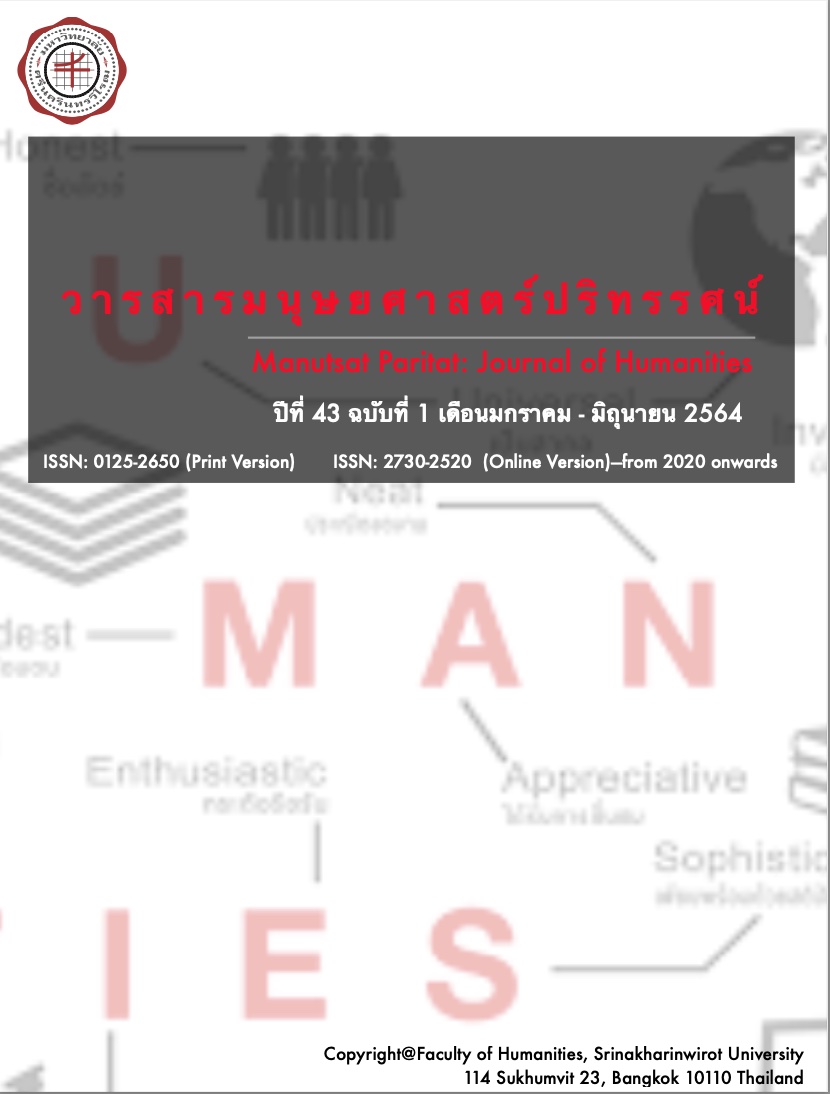การพัฒนาทักษะการอ่านเชิงวิเคราะห์และการเขียนเชิงวิพากษ์ของนิสิตระดับปริญญาบัณฑิตชั้นปีที่ 1 ในหลักสูตรปรัชญาและศาสนาด้วยการเรียนรู้เชิงรุก
Main Article Content
บทคัดย่อ
การวิจัยนี้มีวัตถุประสงค์เพื่อ 1. พัฒนารูปแบบการเรียนรู้เชิงรุกในการเรียนการสอนรายวิชา ปญ 106 การอ่านและเขียนทางปรัชญา 2. พัฒนาทักษะการอ่านเชิงวิเคราะห์ของนิสิตระดับปริญญาบัณฑิตชั้นปีที่ 1 ในหลักสูตรปรัชญาและ ศาสนา ที่ลงทะเบียนเรียนรายวิชา ปญ 106 การอ่านและเขียนทางปรัชญา 3. พัฒนาทักษะการเขียนเชิงวิพากษ์ของนิสิตระดับปริญญาบัณฑิตชั้นปีที่ 1 ในหลักสูตรปรัชญาและ ศาสนา ที่ลงทะเบียนเรียนรายวิชา ปญ 106 การอ่านและเขียนทางปรัชญา ผู้วิจัยใช้แบบทดสอบก่อนและหลังเรียนในการเก็บรวบรวมข้อมูลจากกลุ่มตัวอย่างซึ่งเป็นนิสิตชั้นปีที่ 1 วิชาเอกปรัชญาและศาสนา มหาวิทยาลัยศรีนครินทรวิโรฒ ปีการศึกษา 2562 จำนวน 35 คน การวิเคราะห์ข้อมูลเชิงปริมาณ ผู้วิจัยใช้การวิเคราะห์ค่าที (t-test) เพื่อวิเคราะห์ผลการพัฒนาทักษะการอ่านเชิงวิเคราะห์และการเขียนเชิงวิพากษ์ด้วยรูปแบบการเรียนรู้เชิงรุก ผลการวิจัยพบว่าผู้เรียนมีการพัฒนาทักษะการอ่านเชิงวิเคราะห์และการเขียนเชิงวิพากษ์หลังเรียนเพิ่มขึ้นจากก่อนเรียนอย่างมีนัยสำคัญทางสถิติที่ระดับ .05
Article Details
การคัดลอก ตีพิมพ์ซ้ำ การเผยแพร่ซ้ำบทความใด ๆ ก็ตามที่ปรากฎอยู่ในวารสารมนุษยศาสตร์ปริทรรศน์ ถือเป็นการละเมิดสิทธิในความเป็นเจ้าของของบทความดังกล่าวที่ปรากฎอยู่ในวารสารมนุษยศาสตร์ปริทรรศน์ กรุณาติดต่อ MPJHthaijo@gmail.com เพื่อขออนุญาตคัดลอก ตีพิมพ์ซ้ำ เผยแพร่ซ้ำบทความใด ๆ ก็ตามที่ปรากฎอยู่ในวารสารมนุษยศาสตร์ปริทรรศน์ ลงในสื่อสิ่งพิมพ์ต่าง ๆ หรือสื่อออนไลน์
เอกสารอ้างอิง
มหาวิทยาลัยศรีนครินทรวิโรฒ. คณะมนุษยศาสตร์. (2561). หลักสูตรศิลปศาสตรบัณฑิต สาขาวิชาปรัชญาและศาสนา หลักสูตรปรับปรุง พ.ศ.2561.
Baker, K.M. (2016). “Peer review as a strategy for improving students’ writing process”. Active Learning in Higher Education. 17(3): 179–192.
Barnes, D. (1989). Active Learning. Leeds University TVEI Support.
Jones, J.A. (2019). “Scaffolding self-regulated learning through student-generated quizzes”. Active Learning in Higher Education. 20(2): 115–126.


